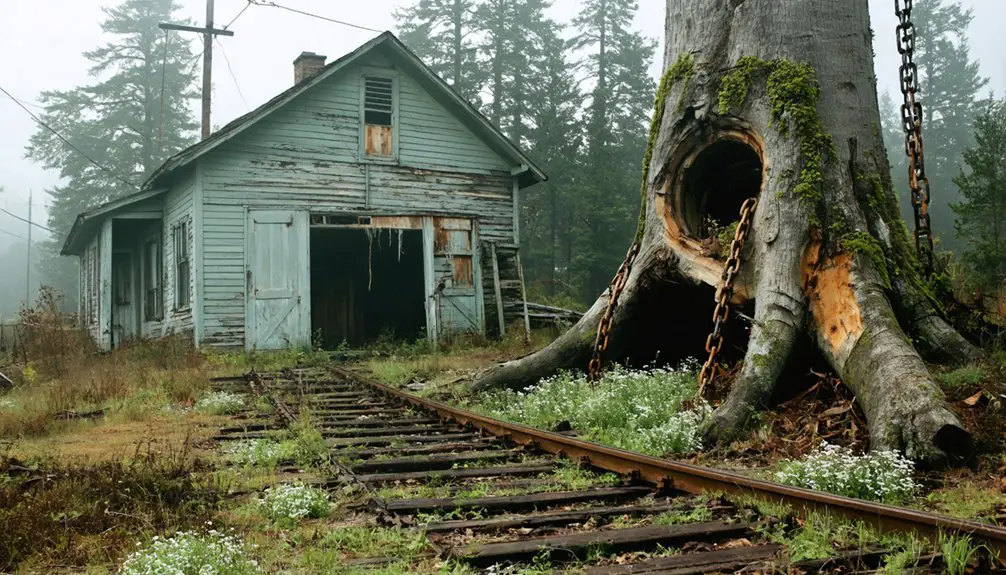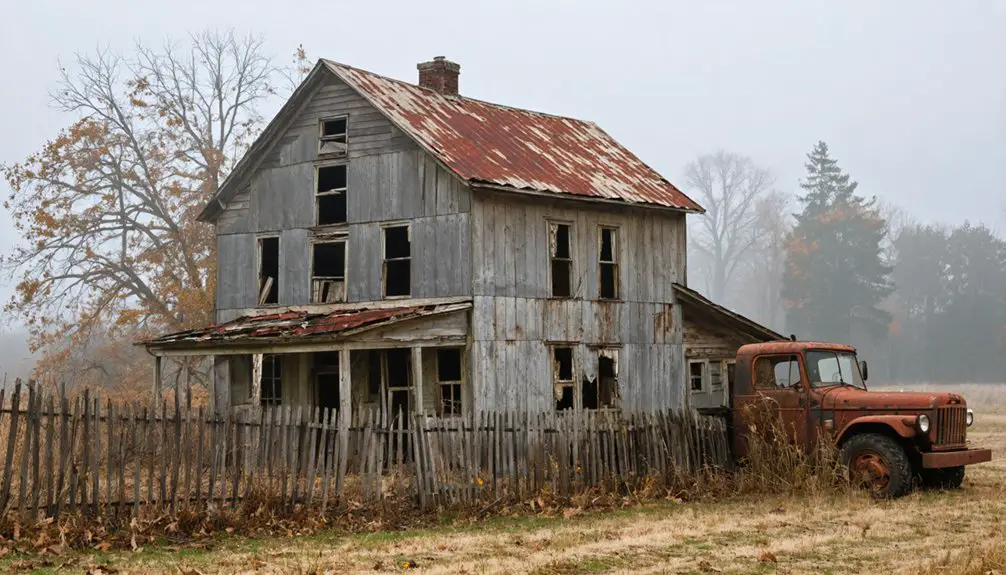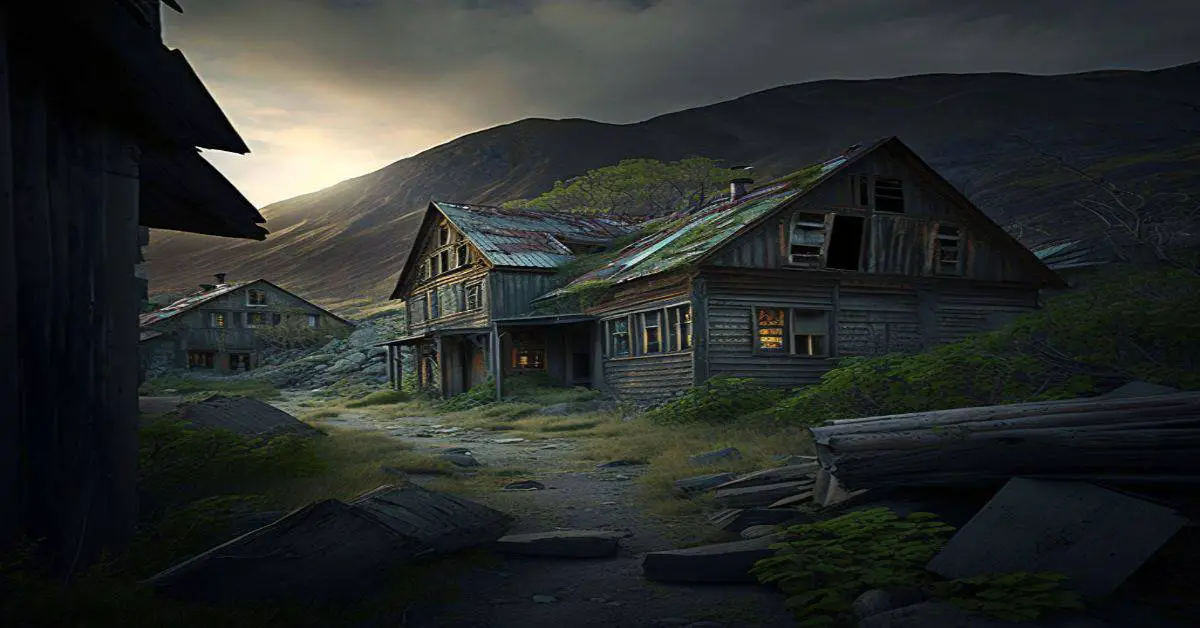You’ll find the ghost town of Stratford hidden in Michigan’s Missaukee County, where a thriving lumber community of 1,200 once lived. Founded in 1897 by Thayer Lumber Company, the town flourished around 13,400 acres of pine forest near Higgins Lake. By 1910, depleted timber resources led to its abandonment, with only a wooden sign and scattered foundations remaining today. The story of this vanished boomtown reveals much about Michigan’s lumber era legacy.
Key Takeaways
- Stratford was established in 1897 by Thayer Lumber Company, growing to 1,200 residents during its peak lumber production years.
- The town’s economic foundation relied solely on pine lumber processing, with operations supported by vital railroad connections until 1910.
- Essential infrastructure included worker housing, sawmills, general stores, and rail systems serving three daily work shifts.
- By 1908, depleted pine forests led to business closures, railroad removal, and rapid population dispersal.
- Today, only a wooden sign and plaque mark the location, with dense vegetation covering former building foundations on state-owned land.
The Birth of a Lumber Town
While Michigan’s lumber industry boomed in the late 1800s, Thayer Lumber Company established Stratford in 1897 after acquiring 13,400 acres of pristine red and white pine forest near Higgins Lake.
Located in Norwich Township, Missaukee County, this lumber camp quickly transformed into a bustling community with essential infrastructure to support its growing workforce. At its peak, Stratford was home to 1,200 residents.
Nestled in Missaukee County’s Norwich Township, Stratford evolved from a simple logging camp into a vibrant industrial settlement.
You would’ve found a thriving railroad station about five miles west of Higgins Lake, where trains stopped six days a week to haul timber. The railroad line terminated at the W.J. Morey Camp, where a sawmill processed the harvested logs.
Thayer Lumber Company, alongside Manistee Lumber Company, invested in community infrastructure by building worker housing, sawmills, and boarding houses.
The town’s development included a post office, general store, and saloons, creating a self-sufficient hub for the hardworking residents who called Stratford home.
Life in Stratford’s Glory Days
If you’d visited Stratford during its peak lumber years, you’d have found workers rising before dawn to put in long days at the sawmill or logging camps, returning home exhausted as the sun set.
After dark, residents would gather at local general stores to swap stories and news, while some sought entertainment at community dances or traveling shows that occasionally passed through town. Some residents had moved from nearby Midland region communities seeking new opportunities.
Despite the physically demanding work schedules, families made time for church gatherings and community picnics, creating strong social bonds that helped them cope with their relative isolation. The town reached its peak of 52,690 residents in 2014, marking the height of its population growth before showing signs of decline.
Daily Worker Routines
Three distinct work shifts defined daily life in Stratford during its peak lumber years from 1898 to 1910. You’d find lumberjacks starting before dawn, swinging their axes through dense pine forests.
Meanwhile, sawmill operations kicked into gear as workers processed the incoming logs into marketable lumber at the east-end mill. Production reached an impressive 100 million board feet annually during the peak years.
Throughout the day, you’d witness train crews loading cut timber and coordinating six-day-a-week shipments to Michigan’s hungry markets. The town thrived as a lumber camp station, serving as a vital transportation hub for the region’s timber industry.
After grueling shifts, workers would head to the saloon or boarding house to rest. The general store kept you supplied with tools and provisions, while the post office connected you to the outside world.
Life wasn’t easy – the physical demands of lumber work shaped every aspect of your daily routine in this bustling railroad town.
Social Life After Dark
During Stratford’s lumber boom years, social life after dark centered around three bustling establishments: the local saloon, boarding house, and general store.
You’d find locals and transient workers mingling over the saloon’s specialty spirit, “Bottled for the Ladner Bros.,” while sharing stories and playing cards. Nighttime gatherings often grew rowdy, with some revelers landing in jail until the next freight train rolled through.
The boarding house buzzed with social activity as workers gathered after their shifts, while Pete The Butcher’s famous meats drew folks together for impromptu feasts. Workers earned $5 per day after proving themselves for three months, which kept the social scene lively.
The boarding house buzzed with social activity as workers gathered after their shifts, while Pete The Butcher’s famous meats drew folks together for impromptu feasts.
Seasonal lumber work brought waves of temporary residents, creating a dynamic atmosphere that peaked during harvest times. The town reached its greatest vitality with a peak population of 600 in 1911.
Until the general store burned down in 1927, you’d find townspeople congregating there well into the evening hours.
Railroad and Economic Foundation
You’ll find the Grand Trunk and Buffalo & Lake Huron railways’ arrival in 1856 established Stratford as a crucial junction point, particularly with the opening of the extensive Motive Power Shops in 1873.
The railway’s strategic location helped connect the region’s booming lumber operations to broader markets while providing stable employment through its maintenance facilities and worker housing. The massive nineteen-acre site supported multiple maintenance operations across its expansive grounds. Like other major rail systems, the facilities included two roundhouses for servicing locomotives.
As the pine forests were depleted and rail technology evolved, Stratford’s economic foundation weakened, leading to the community’s eventual decline.
Rail Transport Networks
Railroad infrastructure formed the beating heart of Stratford, Michigan, when the first tracks arrived in 1898 alongside the town’s founding as a lumber settlement.
You’ll find that railroad expansion quickly turned Stratford into a critical junction point, with the Grand Trunk Railway establishing a Prairie-style station on Shakespeare Street by 1913.
The town’s sophisticated freight management system included telegraph towers, rail yards, and express mail facilities that controlled regional traffic flow.
Multiple railways initially competed for access, though Grand Trunk Railway eventually consolidated operations, expanding its maintenance facilities.
Through these networks, you could’ve shipped lumber from Stratford’s virgin pine forests to distant markets until 1910, when resource depletion led to the town’s decline and the eventual dismantling of its once-bustling rail system.
Lumber Industry Connections
While Stratford’s railroads provided the physical network, the town’s economic foundation rested firmly on 13,400 acres of virgin red and white pine acquired by the Thayer Lumber Company in 1897.
You’ll find that lumber production defined Stratford’s very existence, with major companies like Thayer and Manistee Lumber establishing a vertically integrated operation that shaped the community’s economic sustainability.
The timber industry’s impact on Stratford was profound:
- Companies developed extensive infrastructure including sawmills, logging camps, and storage facilities
- A six-day-per-week rail service connected Stratford’s lumber to broader markets
- The town’s entire economic ecosystem depended on processing and transporting valuable pine lumber
This intensive resource extraction lasted until about 1910, when the depletion of virgin pine ultimately led to Stratford’s decline.
Decline After Pine Depletion
Once the last pine logs were hauled out between 1908-1910, Stratford’s fate was sealed.
The town’s economic vulnerability became starkly apparent as its single-industry foundation crumbled. Without alternative employment options, Stratford’s 1,200 residents had no choice but to seek opportunities elsewhere.
The railroad, which had run six days weekly for twelve years, ceased operations when the pine was depleted. As tracks were dismantled, Stratford’s isolation deepened.
The town’s poor resource management caught up with it – businesses closed, including the saloons, general store, and hotel.
Within just a few years, Stratford stood completely abandoned. By 1937, the State of Michigan purchased the site, and nature began reclaiming what was once a bustling lumber town.
The Rise and Fall of the Timber Empire

Before Michigan’s timber industry transformed the state’s economy, French settlers had already begun harvesting lumber for forts, trading posts, and missions.
The timber trade exploded when New England operators, facing depleted forests back east, brought their experienced crews to Michigan’s virgin timberlands.
You’ll find the economic cycles followed a familiar pattern in Stratford and across the state:
- Steam-powered sawmills replaced water-powered operations, dramatically increasing production and creating wealthy timber barons.
- “Shanty boys” lived in seasonal logging camps, floating massive logs down rivers to bustling mill towns.
- Land speculators aggressively acquired forests for as little as $1.25 per acre, often manipulating the Homestead Act.
What seemed like an endless resource vanished within decades, as Michigan’s old-growth forests fell to saw and axe between 1870 and 1890.
Abandonment and Nature’s Reclamation
The rapid depletion of Michigan’s timber left ghost towns scattered across the state, and Stratford’s story mirrors this pattern of boom and bust. By 1908, you’d have witnessed the last timber shipments leave town, marking the beginning of one of Michigan’s most complete abandonment narratives.
The population of 1,200 quickly dispersed, and by 1910, even the railroad tracks were torn up.
Nature’s ecological restoration took hold after the state purchased the land in 1937. They demolished all remaining structures, and the forest reclaimed what was once a bustling lumber town.
Today, you’ll find no trace of the original buildings – just dense vegetation where streets and sawmills once stood. The virgin pines may be gone, but a new forest has emerged, transforming Stratford’s industrial past into a serene woodland.
Modern-Day Remnants and Legacy
Today’s visitors to Stratford’s former location will find little evidence of its bustling past, save for a wooden sign near N. 13 Mile Road and a commemorative plaque marking where key buildings once stood.
Nature has completely reclaimed this former lumber town, with dense vegetation covering any remaining foundations.
While the physical town has vanished, Stratford’s legacy lives on as a point of local curiosity, preserved through:
- Oral histories and regional ghost town collections documenting its story
- State-owned public land offering recreational opportunities on former town grounds
- A network of blogs, websites, and social media keeping interest alive
The site now serves as a powerful reminder of Michigan’s lumber heritage and demonstrates nature’s ability to heal and transform abandoned industrial landscapes.
Planning Your Visit to the Lost Town
Planning your journey to Stratford’s historic site requires careful preparation and an adventurous spirit. You’ll need a vehicle capable of handling rural roads to reach the trailhead parking area near N. 13 Mile Road, about 13 miles west of Higgins Lake.
Essential visiting tips include bringing durable footwear, insect repellent, water, and navigation tools, as you’ll encounter thick brush and rugged terrain. There aren’t any facilities nearby, so pack accordingly.
For safety precautions, stick to daylight hours and watch your footing among the overgrown foundations.
While you won’t find standing structures, you can explore the commemorative plaque and directional signposts that mark where buildings once stood.
Consider weather conditions when planning your visit, as Michigan’s seasons greatly impact site accessibility.
Frequently Asked Questions
Were There Any Major Fires or Disasters During Stratford’s Existence?
You won’t find any documented fire incidents or disaster impacts in historical records. The town’s decline came purely from depleted timber resources, not from catastrophic events during its operational years.
What Happened to the Residents’ Graves and Cemeteries After Abandonment?
You’ll find no clear records of grave preservation or cemetery relocation efforts. While some lumber towns preserved burial grounds, Stratford’s 1937 demolition and subsequent overgrowth have obscured any traces of residents’ final resting places.
Did Any Notable Crimes or Lawlessness Occur in Stratford?
You’ll find no documented crime history or notable law enforcement activity in the records. The town operated as a typical lumber community without any significant criminal incidents during its existence.
What Indigenous Tribes Originally Inhabited the Area Before Stratford’s Establishment?
Pristine and powerful Potawatomi and Ottawa peoples, part of the Anishinaabe history, called this land home. You’ll find their tribal significance reflected through hunting, fishing, and farming activities across Michigan’s southern territories.
Were There Any Attempts to Revive or Resettle Stratford After 1910?
You won’t find any documented revival efforts or resettlement plans after 1910. When the state bought the land in 1937, they demolished remaining structures and left it undeveloped for recreational use.
References
- https://99wfmk.com/stratford-ghost-town-missaukee-county/
- https://99wfmk.com/stratford-michigan-ghost-town-gone/
- https://lostinmichigan.net/the-ghost-town-of-stratford/
- https://www.nailhed.com/2017/10/the-ghost-town-that-moved.html
- https://www.hmdb.org/m.asp?m=182807
- https://koster.typepad.com/files/earlyhistoryofmissaukeereaderfinal.pdf
- https://www.neilsberg.com/insights/stratford-ct-population-by-year/
- https://en.wikipedia.org/wiki/Midland
- https://en.wikipedia.org/wiki/Stratford
- https://www.ons.gov.uk/visualisations/censusareachanges/E07000221/


